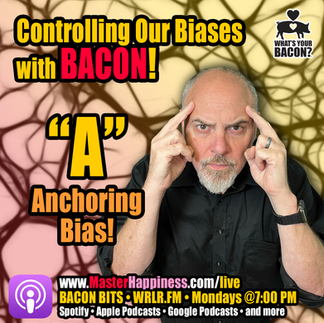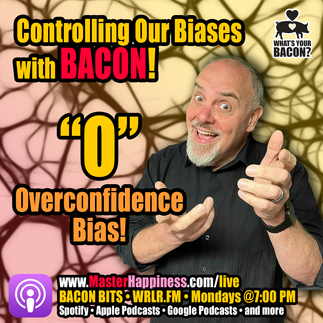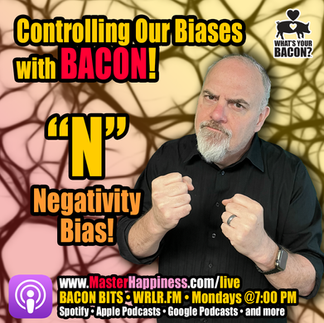Take control of your Biases with BACON!
- Marty Jalove

- Jul 11, 2023
- 6 min read
We all make decisions every day, whether consciously or subconsciously. Some are easy, while others confuse and overwhelm us with the possibilities and choices available. Sometimes, we make choices that we later regret and wonder why we even made them in the first place. The answer to this dilemma lies in our cognitive biases and heuristics. They guide and shape our thinking, often without us realizing it, resulting in irrational and sometimes detrimental choices.
Heuristics are mental shortcuts or "rules of thumb" that our brains use to simplify decision-making. They speed up the process of finding a satisfactory solution, particularly under conditions of uncertainty or limited information.
Follow us at: www.MasterHappiness.com/live or “Bacon Bits with Master Happiness” on Apple Podcast, Spotify, Google Podcast, Amazon Music, Audible, iHeart Radio or wherever you listen to your favorite podcasts.
While heuristics can be incredibly useful, they can also lead to cognitive biases. Cognitive Biases are systematic errors in thinking that affect the decisions and judgments that people make. These biases often work because of our brain's attempt to simplify information processing. They are a by-product of our brain's use of heuristics. Unlike heuristics, which are intentionally used shortcuts, biases typically operate unconsciously and can lead to faulty decisions.
So, the key difference here is that heuristics are mental shortcuts used to speed up decision making, while biases are the negative side effects of those shortcuts that can skew our thinking and decision-making processes.
Here are a few Examples of Heuristics:
B - Best Guess" Heuristic: This cognitive shortcut involves deciding based on what intuitively seems like the most sensible choice under the given circumstances. It's often used when the situation is ambiguous or there's insufficient information to make a detailed analysis. For instance, if you're unsure of an answer during a multiple-choice test, you might use your 'best guess' based on the knowledge you have. This can be a quick and efficient way to make decisions, but it can also lead to errors if the 'best guess' isn't the best choice.
A - Availability Heuristic: This is when people make judgments about the probability of events based on how easy it is to think of examples. For instance, after seeing news about a car theft, you might overestimate the probability of car thefts in general.
C - Consistency Heuristic: This cognitive shortcut involves making decisions based on our desire to be consistent with what we have previously thought or done. We tend to believe what is consistent with our previous beliefs and ignore or challenge what contradicts them. For example, if you have always believed that eating organic food is healthier, you're likely to continue believing this, even when presented with information that contradicts it. This heuristic can help us make quick decisions, but it can also prevent us from accepting new information and changing outdated beliefs.
O - Occam's Razor Heuristic: This principle suggests that the simplest explanation or strategy tends to be the best one. When faced with multiple explanations for an event or multiple solutions to a problem, people tend to choose the simplest one that requires the fewest assumptions or steps. For example, if your car won't start, the Occam's Razor heuristic would lead you to first check if there's gas in the tank before considering more complex issues like engine failure. While this heuristic can help speed up decision making, it may also lead to oversimplification in complex situations.
N - Novelty Heuristic: This cognitive shortcut involves favoring new or novel ideas over older or more familiar ones. It's often used when making decisions about what to pay attention to, as we're naturally drawn to new and different things. For example, in a grocery store, you might be more likely to notice and consider buying a new product that's prominently displayed, even if it's not something you were originally planning to buy. While this heuristic can help us discover new things, it can also lead us to overlook or undervalue tried-and-true options.
Here are a few Examples of Biases:
B - Bandwagon Effect: This is a social cognitive bias where individuals tend to do or believe things because many other people are doing or believing the same. Essentially, it's the 'follow-the-crowd' mentality.
A - Anchoring Bias: This bias occurs when individuals rely too heavily on the first piece of information they encounter (the "anchor") when making decisions. For example, if you first see a shirt that costs $200, then see a second one for $100, you're likely to see the second shirt as cheap.
C - Confirmation Bias: This is the tendency to search for, interpret, favor, and recall information in a way that confirms one's preexisting beliefs or hypotheses. It's why we often only listen to news that aligns with our views.
O - Overconfidence Bias: This is a well-established bias where someone's subjective confidence in their judgments is reliably greater than their objective accuracy. In simpler terms, it's when you are more confident than you should be based on the facts.
N - Negativity Bias: This is the tendency to give more weight to negative experiences than positive ones. People with this bias feel that "bad is stronger than good" and will perceive threats more than opportunities in each situation.
What if there was a way to control our biases and make better decisions, leading to a happier life? A little BACON may do just the trick.
B – Be aware of your biases: The first step in controlling our biases is to become aware of them. We all have biases, shaped by our experiences, culture, upbringing, and background. Knowing what they are and how they affect our thinking is the key to making better decisions. We can start by recognizing when we are making decisions based on gut instinct rather than analyzing the facts objectively. We should also be aware of our prejudices and beliefs that influence our decisions.
A – Analyze the information: Once we are aware of our biases, the next step is to analyze the information. We need to question our assumptions, challenge our beliefs, and seek out alternative viewpoints. We should gather data, analyze it objectively, and weigh the evidence before deciding. This helps us avoid making decisions based on incomplete or inaccurate information.
C – Consider the context: The context in which we make decisions also plays a crucial role in controlling our biases. Our emotions, surroundings, and the people we interact with can impact our choices. We need to consider the context and its influence on us. We can do this by taking a step back, reflecting on why we are making a particular decision, and the factors influencing it. This helps us make more informed choices.
O – Overcome your biases: Overcoming our biases is a challenging but necessary step towards controlling them. We can do this by questioning our assumptions, seeking feedback, and being open-minded. We need to examine our beliefs and biases and challenge them if they do not align with facts and evidence.
N – Navigate the outcome: After deciding, we need to navigate the outcome. It is essential to reflect on the decision, its consequences, and whether we achieved the desired objective. We need to be accountable for our decisions and understand the impact they have on our lives. This helps us improve our decision-making in the future.
Our cognitive biases and heuristics shape our thinking, often without us realizing it. We can take control of our biases by being aware of them, analyzing information, considering the context, overcoming them, and navigating the outcome. By doing so, we can make better decisions, leading to a happier life.
As a simple exercise, we can reflect on our past decisions and identify the biases that influenced them. We can then use the B.A.C.O.N. method to make better choices in the future. Let us take control of our biases, one decision at a time, and enjoy the happiness that follows.
“When dealing with people, remember you are not dealing with creatures of logic, but with creatures bristling with prejudice and motivated by pride and vanity.”
– Dale Carnegie, How to Win Friends and Influence People
Want to learn how to take control of your Biases with BACON?
Follow us at: www.MasterHappiness.com/live or “Bacon Bits with Master Happiness” on Apple Podcast, Spotify, Google Podcast, Amazon Music, Audible, iHeart Radio or wherever you listen to your favorite podcasts.
Or catch us LIVE on "BACON BITS with Master Happiness" on www.WRLR.fm 98.3 FM, Monday Night at 7:00 PM and start making your life SIZZLE!
Learn more at: www.MasterHappiness.com/live
Small Businesses go to out: www.WhatsYourBacon.com
#SalesCoach #EmployeeRetention #Keynote #Career #Relationships #MasterHappiness #Jalove #Bacon #WRLR #BaconBits #MartyJalove #WhatsYourBACON #TeamBuilding















Comments